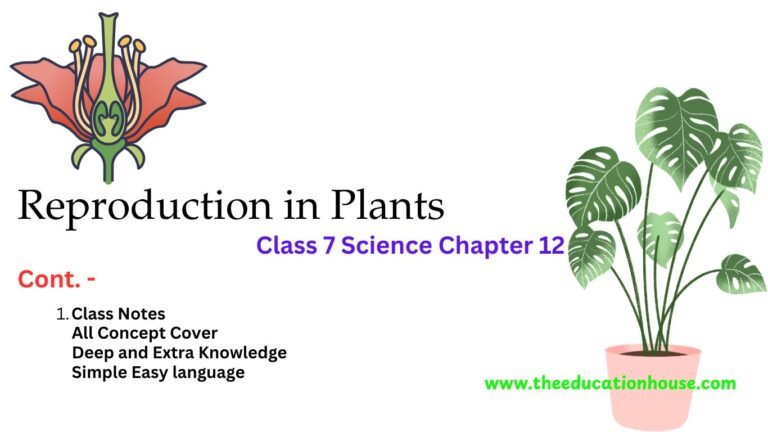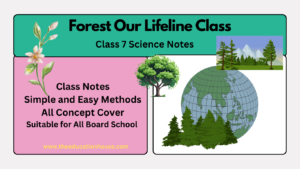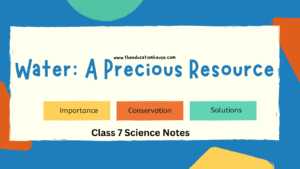Reproduction in Plants Class 7 Notes
Welcome to Reproduction in Plants Class 7 notes under Class 7 Science, a special series of The Education House. In Reproduction in Plants Class 7 notes, we will cover class notes and detailed explanations with simple and easy language. The Education House covers all topics. The Education House team is always dedicated to providing the best education materials to our learners. Reproduction in Plants Class 7 notes is the most important chapter regarding how plants reproduce and generate new plants. This article will help to understand the concept of reproduction in plants. Class 7 Science chapter 12 is the most important for biological knowledge
Table of Contents
Chapter 12 Reproduction in Plants Class 7 notes
As we discuss the name of this chapter Reproduction in Plants, now the first question in our mind is “What is reproduction?”
Reproduction: – Reproduction is the process in which new individuals are produced by their parents. As we know human reproduction is only done with sexual methods. But in plants, there are many methods of reproduction.
Reproduction in Plants
In our daily life, we eat many fruits and the seeds are thrown away. After some time, we see the seeds are getting changed in a plant. This is reproduction. But in Reproduction in Plants Class 7 notes, we will discuss deep about the reproduction in plants.
Flower: – Flowers are one of the reproduction parts of plants.
We divide the reproduction in plants into two categories – 1. Asexual Reproduction 2. Sexual reproduction

Asexual Reproduction
In this category of reproduction seeds are not required to produce new plants. Asexual reproduction has many types some of which are explained below: –
Vegetative Propagation: Reproduction in plants by roots, stems, leaves, and buds is called vegetative propagation. Roots, leaves, stems, and buds are known as plant vegetative parts.
Example: – 1. Cut stems of rose flowers and keep them in the soil it grow and produce a new plant.
- we observe some buds in potatoes, if we cut these buds and bury them in soil it converts into a new plant.
Budding: –
In this process of reproduction, one bud-like structure is produced in the main body and it grows with time and after some time it gets separated from the main body. After that, it develops like new.
Yeast is an example of budding reproduction. As we know yeast is a single-cell plant. Sometimes it creates a chain of buds.
Fragmentation: –
In this process of reproduction, the plant divides itself into two or more parts and the divided parts grow independently and after some time it divides itself. This process repeats again and again.
Ponds algae is the best example of fragmentation.
Spore formation: –
In this process of reproduction, the spores of plants are present in the air and when they get favorable conditions it get germinate.
Fungai is the best example of Spore Formation reproduction.
Sexual Reproduction
In class 6 science we studied the structure of flowers and flower is the reproductive part of plants. In Reproduction in Plants Class 7 notes, we will try step-wise the process and type of reproduction in plants. Stamens is the male reproductive part and pistil is the female reproductive part. Some flowers contain both of them and some have only one of them. So according to this, we separate the flower into two parts.
- Unisexual flower: – These are those flowers that contain only one pistil or stamens. Corn and papaya are examples of unisexual flowers. Both male and female parts may be present in the same plants or different plants.
- Bisexual Flower: – These are those flowers that contain both pistils and stamens. Mustered and rose are examples of bisexual flowers.
Pollen grains are contained by Anther. Pollen grains are male gametes.
Pistil contains stigma, style, and ovary. The ovary contains ovules which can be one or more. Female gametes/eggs form in ovules. When a male and female fuse it makes a zygote.
Now the question is how the pollens are transferred to stigma. As we know pollen is very lightweight and it can easily carry with water and air. so air and water are important transporter of pollens. Insects and birds are also part of this process.
Pollination: –
The transfer of pollen from anther to stigma is called pollination. There are two types of pollination: –
- Self-pollination: – if pollens land on the same flower or different flower of the same plant stigma is called Self-pollination.
- Cross-pollination: -if pollens land on the same kind of flower of different plant stigma is called cross-pollination.
Fertilization: –
When pollens land on stigma and it gets fusion, it creates a cell called Zygote. The process of fusion of male and female is called fertilization.
Embryo: – when the zygote gets developed it converts into Embryo.
After fertilization, the ovary of the flower into fruit, and the rest of the part gets down. Seeds are developed from ovules.
Conclusion of Reproduction in Plants Class 7 notes
In Reproduction in Plants Class 7 notes, The Education House team covers all concepts with easy and simple methods of explaining. Class 7 Science chapter 12 notes are all about simple the harder term to simple. The education house team is always dedicated to providing the best education materials to our learners. If you like Reproduction in Plants Class 7 notes, you can check other chapter notes of Class 7 Science as well as other class notes.
Class 7
Class 6
- Class 6 science chapter 2 Components of Food
- class 6 science chapter 2 hindi medium notes and questions answers
- Fibre to Fabric class 6 notes
- Fibre to Fabric class 6 questions and answers
- Class 6 science chapter 4 notes sorting materials into groups
- Sorting materials into groups class 6 questions answers
- Separation of Substances class 6 notes
- Separation of Substances Class 6 Questions Answers Chapter 5
- Changes Around us Class 6 notes and NCERT Solutions
- Getting to Know Plants Class 6 notes NCERT Solutions
- Class 6 chapter 8 notes NCERT solution
- Class 6 chapter 9 notes NCERT solutions
- Class 6 Chapter 10 Notes NCERT Solutions
- Class 6 Chapter 11 Notes
- Chapter 12 Notes
- Chapter 13
- Air Around Us Chapter Notes






